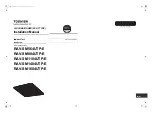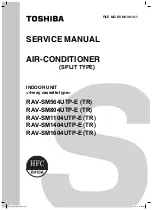
PTEC-M-1A
38
WARNING!
To prevent death, personal injury or
property damage due to electrical
shock, only qualified service
personnel are authorized to use the
diagnostic box or this procedure.
WARNING!
To prevent death, personal injury or
property damage due to electrical
shock, take extreme precautions
when using this procedure. Both
high (230/208 or 265 VAC) and low
(24 VAC) voltages will be present.
•
Indoor/Outdoor Coil Thermistors
-
In the cooling mode, if the
compressor is engaged
continuously for 20 minutes and
the Indoor Coil Thermistor is below
30 degrees the compressor is
disengaged until the ICT rises
above 45 degrees. The Outdoor
Coil Thermistor senses coil
temperature which correlates to
outdoor air temperature. Heat
pump operation can operate as
low as 24°F outdoor temperature
depending upon humidity
conditions and/or the balance point
of the system. After defrost is
initiated, the compressor remains
off for thirty minutes and resumes
operation when the outdoor coil
temperature reaches 33°F. Electric
resistance heat will maintain the
ambient room temperature
anytime the temperature falls 4°F
below the room set point
temperature.
•
Load Shedding
- The LS & IN
terminals are used for load
shedding. A switch can be added
to close the circuit to lock out the
compressor and electric heat when
the power company or energy
management system is trying to
reduce its load for a specified time.
Control Board
Characteristics and
Diagnostics
•
Sample Before Start
- The SBS
routine is used in the cooling
mode. This routine runs the unit
fan on low speed for up to 120
seconds. The sample fan is aborted
if compressor demand is detected.
To avoid unnecessary sampling the
period between samples will be
based on specific room conditions.
The default sample before start
period after a power up is 5
minutes ± 20%. The period is
corrected every time a sample run
is completed without a compressor
demand. The minimum sample
period is 5 minutes and the
maximum period is 15 minutes.
•
Remote Temperature Sensor
- An
auxiliary temperature sensor
(RTS02) may be connected to the
control that senses actual room
temperature. This sensor replaces
the Indoor Ambient Thermistor
and will connect to the Indoor Air
terminals on the control.
•
Transfer Fan
- A transfer fan may
be used if a user supplied relay is
connected to TF1 and TF2. Make
sure the relay is a manufactured
approved relay. The relay will be
energized whenever the blower/fan
relay is energized.
•
Front Desk Control
- The front desk
control terminals are FD1 and FD2.
These terminals will provide a
connection for a user supplied
switch that will allow the operation
of the unit to be remotely defeated.
•
Emergency Hydronic Heat
- A
switch can be added to the EH & IN
terminals to close the circuit to
enable the fan, enable the heater
relay and lockout the compressor
to continue minimum operations
with auxiliary power, if the main
power goes out.
Содержание PTEC-070
Страница 22: ...PTEC M 1A 22 Refrigeration System PTEC Refrigeration System...
Страница 54: ...PTEC M 1A 54 Schematic Diagrams PTEC and PTHC Condensate Pump One Stage Heat...
Страница 55: ...55 PTEC M 1A Schematic Diagrams PTEC and PTHC Condensate Pump Two Stage Heat...
Страница 56: ...PTEC M 1A 56 Schematic Diagrams PTEC and PTHC Power Vent One Stage Heat...
Страница 57: ...57 PTEC M 1A Schematic Diagrams PTEC and PTHC Power Vent Two Stage Heat...
Страница 58: ...PTEC M 1A 58 PTEC and PTHC Power Door One Stage Heat Schematic Diagrams...
Страница 59: ...59 PTEC M 1A Schematic Diagrams PTEC and PTHC Power Door Two Stage Heat...
Страница 60: ...PTEC M 1A 60 Schematic Diagrams PTEC and PTHC Condensate Pump with Power Vent One Stage Heat...
Страница 61: ...61 PTEC M 1A Schematic Diagrams PTEC and PTHC Condensate Pump with Power Vent Two Stage Heat...
Страница 62: ...PTEC M 1A 62 Schematic Diagrams Hydronic...
Страница 63: ......
















































